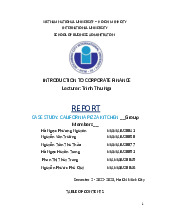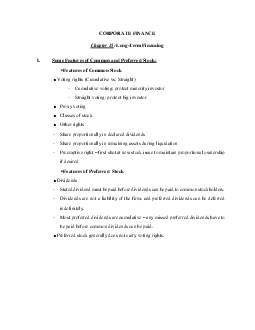




Preview text:
lOMoARcPSD|364 906 32 CORPORATE FINANCE
Chapter 11: RETURN AND RISK: THE CAPITAL ASSET PRICING MODEL (CAPM) I.
Individual Securities: -
The characteristics of individual securities that are of interest are the: ● Expected Return
● Variance and Standard Deviation
● Covariance and Correlation (to another security or index)
II. Expected return, variance and covariance: -
Expected return: E(R) = ∑(pi x Ri) -
Variance: V ar(δ )2 = ∑pi(Ri − E(Ri))2 -
Standard deviation: SD(δ) = √δ2 -
Covariance: Covar(a, )b = ∑pi[RiA − E(RA)] [RiB − E(RB)] -
Correlation: p = covδa (x δa,bb) (− 1≤p≤1) III. The Return and Risk for Portfolios:
E(RP ) = ∑[W xi E(Ri)] (W i : % investment in a certain asset) -
Standard Deviation of a portfolio of 2 assets: √ 2 2 2
δ 2 = √W σ W σ A A + 2 B B +2 δ = W WA B Aρ ,B
Where: pi : probability of state of economy (recession, normal, boom)
Ri : rate of return at each stage of economy (recession, normal, boom)
E(R) : expected return of an assets -
W A : % investment in asset A -
W B : % investment in asset B - ρA,B
: return correlation between A and B lOMoARcPSD|364 906 32 -
By creating a portfolio, risk is much reduced. To minimize risk, should choose
asssets with negative correlation. IV.
The Efficient Set for Two Assets:
- The same return → lower risk. - The same risk → higher return. V.
The Efficient Set for Many Securities: -
The return on any security consists of two
parts. ● First, the expected returns
● Second, the unexpected or risky returns -
A way to write the return on a stock in the coming month is:
R = R + U Where
R: the expected part of the return
U : the unexpected part of the return
- Any announcement can be broken down into two parts, the anticipated (or
expected) part and the surprise (or innovation):
Announcement = Expected part + Surprise.
- The expected part of any announcement is the part of the information the market
uses to form the expectation, R, of the return on the stock. lOMoARcPSD|364 906 32
- The surprise is the news that influences the unanticipated return on the stock, U. VI.
Diversification and Portfolio Risk:
- Portfolio Risk and Number of Stocks: Where: n: number of shares
- Total risk = systematic risk + unsystematic risk - A systematic risk
is any risk that affects a large number of assets, each to a greater or lesser degree.
- An unsystematic risk is a risk that specifically affects a single asset or small group of assets.
- Unsystematic risk can be diversified away.
- Examples of systematic risk include uncertainty about general economic
conditions, such as GNP, interest rates or inflation.
- On the other hand, announcements specific to a single company are examples of unsystematic risk.
- The standard deviation of returns is a measure of total risk.
- For well-diversified portfolios, unsystematic risk is very small. lOMoARcPSD|364 906 32
- Consequently, the total risk for a diversified portfolio is essentially equivalent to the systematic risk.
- Risk free assets (T-bill): Rf; Standard deviation = 0 - Risky assets (Bond Fund / Stock Fund) VII.
Riskless Borrowing and Lending:
- With a risk-free asset available and the efficient frontier identified, we choose the
capital allocation line with the steepest slope.
VIII. Market equilibrium:
- Beta measures the responsiveness of a security to movements in the market
portfolio (i.e., systematic risk).
βi = covδ ( (2 RRiM,R)M) = p δ(δ(RRMi)) IX.
Relationship between Risk and Expected Return (CAPM):
- Expected Return on the Market: RM = Rf + Market risk premium (MRP) -
Expected return on an individual security (CAPM):
Ri = Rf + βi x (RM – Rf ) lOMoARcPSD|364 906 32
RM - Rf is market risk premium.
- Assume β i = 0, then the expected return is R F. - Assume β i = 1, then R i = R M
Document Outline
- CORPORATE FINANCE




